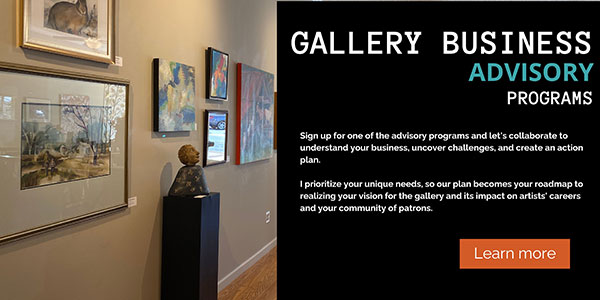Your passion for art was developed in you at some point. It’s what made you want to work in a gallery, right? It also helped you develop a vision for the gallery you are in today. Your vision plays an essential role in your art gallery’s business plan and growth strategy.
How do your passion and vision manifest themselves in the gallery? Are they driving growth through leadership in the gallery business?
Here I want to explore how creating a vision statement as the Owner or Director can help you set business priorities and improve employee leadership. A vision statement also provides direction for artist relationships, branding, sales, and marketing strategies, propelling future growth.
Today’s Relevancy of Your Gallery Vision
If you have been in business for a while, consider if your initial vision is still relevant today. It is so common for an initial idea to be lost because there is so much to put in place and many lessons learned in those early years.
It’s easy to lose sight of the strategic, whole-picture view of where the business is going and get overwhelmed and caught up in the tactical day-to-day work.
Outside influences may change how relevant that initial vision is in your market today. Influences might include new client demands, artists leaving the gallery, developing neighborhoods changing the strength of the gallery location, etc. This is why it is so critical to capture your vision for the gallery business in writing. You may have done this for a business plan at the start and then never looked at it again.
Given all of that, consider if your vision of the gallery is still relevant or does it need to evolve for long-term success. This is an important question that a vision statement can help answer.
Creating a Gallery Vision Statement
First, let me clarify that a vision statement is not the same as a mission statement. Your mission statement is more public-facing and communicates what the gallery does now and for whom.
A vision statement is often an internal message that conveys how the gallery will be in the future. It helps guide your planning priorities and inspires leadership.
Create a written gallery vision statement that is easy to fine-tune throughout the years. Visualize what your gallery, as a business, will be like 3-5 years in the future. Use the questions below to guide your thought process for what could be included in your gallery’s vision statement.
- Do you see a larger exhibition space or an online-only gallery, or will you move to a different location?
- How will people feel about working with your gallery? Will staffing roles change?
- Why will your artists be loyal?
- What motivates your employees to come to work every day?
- How do you envision your role 3-5 years from now? Will you step back from the day-to-day activities or become more focused on a particular area of running the business?
- How do you want to feel about your gallery business?
- How do you want your clients, employees, and artists to feel about being a part of your vision?
- What role will the gallery fill in your market and community?
- How will the business act internally? Will current processes be streamlined, built upon, or eliminated?
- What is the company culture like in the future?
These questions are intended to get your mind thinking about the direction you want to business to go and some of the factors that a role in its success. Your vision statement shows you and others how all your leadership activities fit into the art gallery business plan for the future. Start with the end result, not where your gallery is currently. Remember, this is all about working towards the future.
I recommend thinking three to five years into the future. You want your vision statement to be far enough in the future to work towards but not too far to feel overwhelming or just complete guesswork. I feel this time frame is motivating and still attainable.
Your statement will be a valuable tool for you as you grow and scale the business.
Why is a Written Vision Statement Important?
Research shows that businesses with a written vision statement grow 50% faster than those without. Having your vision written down vs. just in your head makes it easier for you to refer back to and track your progress in making it a reality.
Don’t get hung up on perfection. Your vision statement can change over time. Your interests may change, and new opportunities may arise that excite you, and that’s ok. Get something down on paper to give you a proper framework.
As you put pen to paper, don’t make your statement more than 1-2 pages. Your statement should be easy to grasp. When you do your year-end review of the business, annual planning, and setting goals being able to pull out a written statement will help guide you to keep tactical planning focused on your vision for the future.
To the Point
An art gallery vision statement acts as a blueprint for your priorities and leadership for customer service, branding, sales and marketing strategies, and your future growth. Your vision should be at the center of your art gallery business plan every year, how you run the business and the decisions you make. Let your vision be the unifying force that drives purpose and be the foundation for communicating the value you bring to artists and collectors.
Ensure that not only gallery staff members but also your artists and, to some degree, your collectors, through brand awareness, are crystal clear on your vision for your gallery’s future. Followers support a gallery’s vision that is built on explicit values, character, and the ability to communicate in a way that inspires.
Check out these articles too
How to Create an Annual Art Gallery Strategy Plan



Leave a Reply